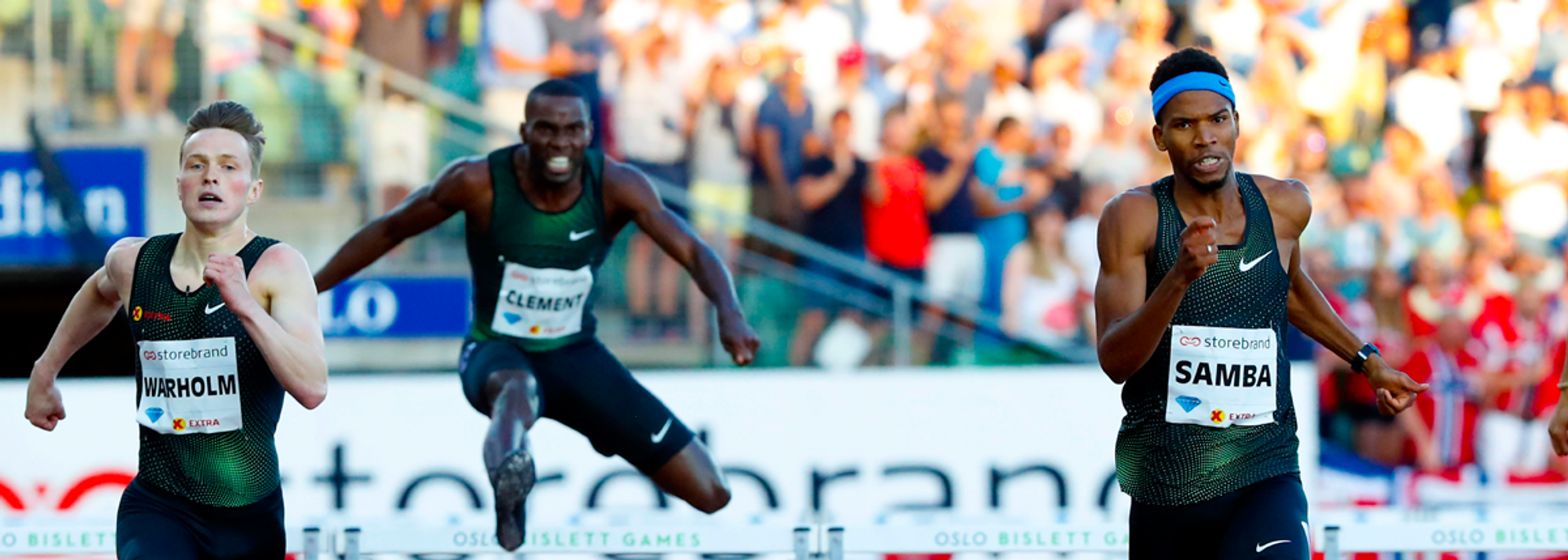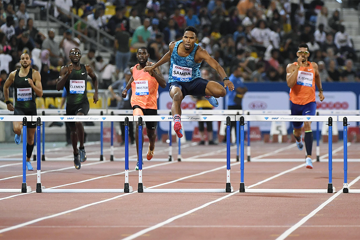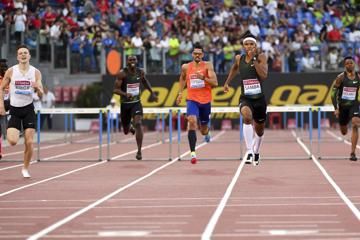Abderrahman Samba on his way to winning the 400m hurdles at the IAAF Diamond League meeting in Oslo (© AFP / Getty Images)
Samba – a Brazilian musical genre or dance style with African roots, renowned for its rhythmical nature and energy.
Samba – a lightning-fast 400m hurdler who grew up in Saudi Arabia, lives in Qatar, has a Mauritanian father, a South African coach, and is, at 22, one of the most exciting talents in the sport today.
Samba – the moves being busted out by the above athlete (first name: Abderrahman) at City Hall in Oslo, shortly after 6pm on Wednesday, the eve of the IAAF Diamond League meeting, to oblige the request of a local TV journalist who wanted to know if his name reflected his nature.
As Samba duly launches into a few swivelling moves, his friend and Qatari compatriot Mutaz Essa Barshim watches and laughs along at the ridiculous sight, surprised and impressed at his ability, even if he’s got some work to do before Carnival comes calling.
“I’m not a good dancer,” said Samba.
The following evening, things are far more serious, Samba settling into the blocks as a hush descends over a packed Bislett Stadium, the crowd anxiously awaiting the performance of local hero Karsten Warholm, who is positioned two lanes outside the Qatari.
It’s the clash everyone was waiting for, and when the gun fires Warholm duly screams out of the blocks with a terrified ferocity that would please Edvard Munch. But as they turn for home, the Norwegian’s power begins to fade, his stride starts to shorten, while Samba, unrelenting, continues to churn out a metronomic rhythm.
A week before, Samba set the Asian 400m hurdles record at 47.48, and as he approaches the line it’s clear that that’s again under threat, but on this night in Oslo it survives. Samba hits the finish in 47.60, a meeting record in the bag.
“That was samba over the hurdles,” he says afterwards with a laugh. “The hurdles is like a dance, and I hope I dance always.”
Football family
For one so accomplished, even at the tender age of 22, little is known about Samba’s background. He was born and grew up in Saudi Arabia but chose to represent Mauritania – his father’s homeland – before eventually switching allegiance to Qatar and moving to Doha in 2015.
“All my family were athletes,” he says. “But all of them footballers.”
In 2011 Samba broke that trend by starting out in athletics, first trying the high jump (where he had a best of 1.90m in his first season), long jump, 200m and 400m. At the age of 18 he had a best of 47.45 for 400m, a time he lowered to 46.04 at the age of 20 after several months’ training in Qatar.
But only last year, at the age of 21, did he transfer his talents to the 400m hurdles, proving himself an astonishing prospect by clocking 48.31 at a meeting in South Africa before claiming victory at the IAAF Diamond League meeting in Doha in 48.44.
However, injuries would hamper him later in the summer. Samba reached the final at the IAAF World Championships London 2017 but was only able to finish seventh in 49.74 as Warholm took gold in 48.35.
But that disappointment helped fuel his fire for 2018, Samba improving rapidly under the continued guidance of Hennie Kotze, the South African who previously coached Kenya’s Nicholas Bett to the world 400m hurdles title in 2015.
Kotze once described viewing his protégés in the 400m hurdles as like “watching a beautiful musical concert” and if that’s true, then his star performer’s season to date has played out like a sweet symphony. Samba broke the Qatari record on his first outing with a 47.90 clocking in Potchefstroom, South Africa, then lowered it again to 47.57 in Doha, before his recent hard-fought victories over Warholm in Rome (47.48) and Oslo (47.60).
Samba is now on the brink of achieving his fifth consecutive sub-48-second performance in back-to-back races. The last 400m hurdler to achieve such a feat was Derrick Adkins back in 1995.
Rising together
The rivalry with Warholm is one that stokes his fire like nothing else, and in Oslo Samba explained how the Norwegian’s presence helps him reach a new level.
“He did great and made the race more exciting by going that fast, forcing me to go with him,” said Samba. “It’s helping us both; everyone goes to the line to fight together and it makes it more exciting for me.”
“The people in the world now see the 400m hurdles as the exciting race on the track, people tune in to see what’s going to happen. Me and Karsten make that race exciting, running sub-48, and that’s good for the sport. In the future we’ll make it faster.”
How much faster? We may get an idea this Sunday, when the IAAF Diamond League moves east to Stockholm, with Samba and Warholm set to lock horns once again in the Olympic Stadium.
And Samba sees plenty of room for improvement. On Thursday he ran with 13 strides between barriers until the seventh hurdle (of 10) but the wind swirling around Bislett forced him to switch down to 14 strides earlier than usual, so he thinks with calmer conditions on Sunday a quicker time is on the cards.
“I hope for another great one, maybe running faster and a new track record,” he says, “but maybe we’ll have a surprise.”
Given his rapid progression, talk has inevitably arisen about the possibility of challenging the world record of 46.78 by Kevin Young, but Samba is not getting ahead of himself. “I can’t give a comment now about the world record, I don’t know,” he says. “But you can be sure I can run faster, maybe close to 47 seconds.
“Always, I think I have more.”
Cathal Dennehy for the IAAF







